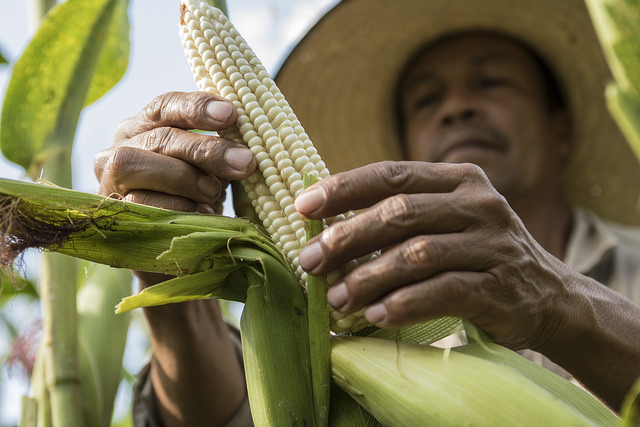Malnutrition is stunting the growth, health, and learning and earning potential of millions of children around the world, including six million in Latin America and the Caribbean. But visit the home of a low-income family and you might be confused — it may look like there is enough food on their plates. However, they’re often suffering from a hidden form of hunger caused by a diet deficient in vitamins and minerals, which can lead to stunted physical and cognitive growth, disease, and even death.
Rural families subsist on staple food crops like maize (corn) and beans because they rarely can afford the fruits, vegetables and protein needed for proper health and development. Today, there is a new solution: naturally enriching the seeds of these staple crops with vitamin A, iron and zinc, a process known as biofortification. A program called HarvestPlus has worked with hundreds of partners to develop more than 200 varieties of biofortified staple crops like sweet potato, cassava, rice and maize across Africa, Latin America and Asia. Experts in nutrition and agriculture have worked together to ensure that these new, healthier foods have sufficiently high levels of nutrients, taste good, are easy to cook, and have the traits that farmers need, including—resistance to insects, diseases, and the effects of climate change.
After years of collaboration and research, the first-ever varieties of biofortified zinc maize developed by HarvestPlus and the International Maize and Wheat Improvement Center (CIMMYT) were recently released by the Colombian and Guatemalan governments. Zinc plays an essential role in maintaining optimal childhood growth and a healthy immune system. In Guatemala, a shocking 46.5 percent of children under five are stunted, and 29.8 percent of the population is estimated to consume inadequate amounts of zinc. A 2016 study indicated that a modest 4 milligrams of extra zinc a day — the target amount for biofortified foods — can have a profound, positive impact on cellular health that helps fight infections and diseases.
Researchers have also ensured that farmers have a choice: higher-yielding hybrid seeds, like the variety released in Guatemala, and lower-cost, lower-yielding varieties that can be replanted for several seasons, such as the maize released in Colombia. Zinc maize joins biofortified varieties of cassava, maize, sweet potato, beans and cowpeas (black-eyed peas) available to families across Latin America, including Brazil, Colombia, Nicaragua, El Salvador, Guatemala, Panama and Honduras. Once biofortified seeds are introduced, consumers can enjoy the nutritional benefits while still enjoying the same foods they know and love. For example, a traditional arepa (corn cake) or tortilla made with biofortified maize tastes the same and will provide up to five times more zinc than one made with the original maize variety.
Public sector partnerships are key to expanding access to these healthier foods. For example, the Colombian government recently included biofortified crops in its Comprehensive National Program for Replacement of Illicit Crops. As part of this program, farmers transitioning away from growing illegal crops will receive seeds and technical expertise from HarvestPlus to grow high-iron beans and zinc maize. Biofortification has also been included in a program to reintegrate former combatants returning to their rural communities after years of civil war. Seed and food companies are also increasingly interested in supplying farmers and consumers with biofortified products. This benefits the farmers as well, by providing them with potential markets.
Biofortification’s results ripple through families and communities — better-nourished children and surplus income are a recipe for success.
